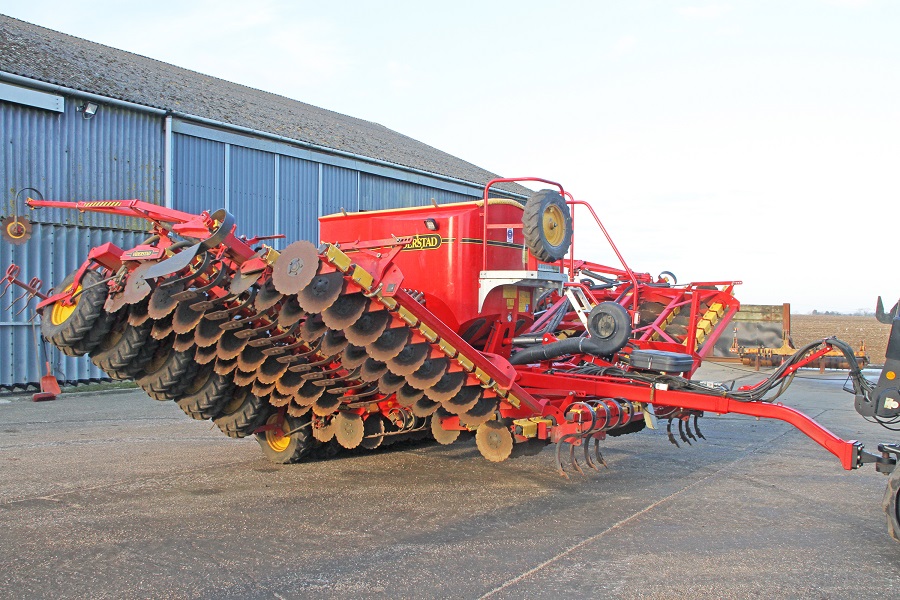Getting more yield out of headlands is a topic provoking interest among many arable farmers, with losses of 10% commonly seen. CPM finds out how one farmer has tackled the challenge through investment in new tines for his drill.
Though we’re yet to see the results in terms of yield, everything looks and feels right.
By Rob Jones
Depending on the shape and layout of your fields, headlands can make up a substantial part of the cropped area on farm.
However, with losses of up to 10% often seen, this less productive ground often tends to bring more headache than reward – with growers increasingly left wondering how they can get more out of such significant parts of the field.
Andrew Robinson, farms manager at Heathcote Farms in Beds, had headlands in mind when deciding to equip the business’s eight-year-old Väderstad Rapid 800S drill with Agrilla tines up front, replacing the System Disc ahead of the coulters.

The tines mean that instead of drilling the headlands first and then having to travel back onto them at the end of a run, Andrew Robinson can drill the field and do the headlands last.
“We were looking at ways to increase efficiency, bearing in mind that headland management can influence average yields,” he says. “The tines mean that instead of drilling the headlands first and then having to travel back onto them at the end of a run, we can drill the field and do the headlands last, taking out any compaction.”
So how exactly does the system work?
Väderstad’s System Agrilla CrossBoard Light consists of three rows of tines in combination with the firm’s CrossBoard levelling board, says Andrew Gamble, Väderstad. “The vibrating tines loosen the soil and break up any clods, then the fine tilth is mixed into the seedbed. As the the tines move soil in the direction of travel, any residues are distributed and the surface is levelled.
“The CrossBoard provides an additional clod breaking and levelling action.”
Operator, Matt Fuller, drills 1200ha per year with the Rapid, across all crops including OSR, but while beans are usually the only spring crop, this year the drill has also been deployed to establish spring wheat and barley.
Cropping is split between two sites, the majority on Hanslope Clay at Toddington with 220ha of green sand further north.
“We had planned to drill winter wheat, using the Rapid after cultivations with a Watkins Quadtill and Väderstad RexiusTwin, but when autumn conditions deteriorated, we switched the cropping plan to spring wheat and barley,” says Matt. “We go in with a Dalbo spring tine cultivator 24 hours before drilling to create a tilth.”
The Rapid was fitted with the System Agrilla front tool over the winter in anticipation of the significant amount of spring work ahead, he adds. “It’s a big workload, and the tines give us the flexibility to go in more challenging conditions, maybe 24-48 hours sooner than we would be able to drill otherwise.
“We won’t drill if it’s too wet, but once the land starts to dry, timing becomes critical.”
In terms of key benefits, Matt says the farm is seeing better germination as a result of switching to the Agrilla tines. “The seeds are going into ideal conditions, with the tines creating a tilth around the seed, as well as offering a lifting and levelling action. The Rapid’s disc coulters can then place seed precisely into the moist soil.”
The Agrilla tines and levelling board can be hydraulically controlled, so he’s able to adjust their working depth as required to suit differing soil types and conditions. “In light soils, the tines are almost out of the ground to avoid moving too much soil, and in heavier ground I will drop them in deeper to create a greater tilth and give the seeds more protection against pre-ems.”
This adjustability also comes in handy on the headland where the tines can also be put in deeper still to take out compaction, adds Matt.
Working the soil a little more, drilling uses a greater amount of fuel on the Quadtrac 620 and is 1-2km/h slower, although output is still a respectable at 60-70ha/day, according to Matt. “We’re keeping the drill in the ground and putting seed into moisture, which should reap benefits.
“The discs are ideal on a bone dry bed, so we would look to return to them for oilseed rape and then decide whether to swap back to tines for later autumn work, or in Jan/Feb look at fitting them for spring work.”
Wearing parts are another consideration. Discs last three or four seasons, and while tine wear will be greater, the first set of points has been hard faced and clocked up 680ha by early April, he adds.
While Andrew’s Rapid 800S drill has earned its keep and covered plenty of ground in eight years, being able to retrofit the tines has proven to be a very cost-effective solution to a major on-farm problem, he says.
“It’s a real advantage that you can fit the tines to an older drill, rather than having to buy new to get their benefits.
“We have to be more flexible in what we do in order to be successful and the Rapid offers that versatility, drilling everything from beans to oilseed rape, producing consistent seedbeds and it will also direct drill.
“The Agrilla tines add to this flexibility and though we’re yet to see the results in terms of yield, everything looks right and feels right.”
Farm facts
Heathcote Farms, Toddington, Beds
- Arable area: 1150ha
- Cropping: Wheat, OSR, beans and barley
- Soil type: Mixed soils ranging from Hanslope Series heavy clays to greensand over clay.
- Mainline tractors: Case Quadtrac 620; Case Quadtrac 535; Case Puma 230; Case Puma 215; Case MXN 190.
- Combine harvester: Claas Lexion 770 with a 12m head
- Cultivations: Watkins Quadtill; Väderstad RexiusTwin




